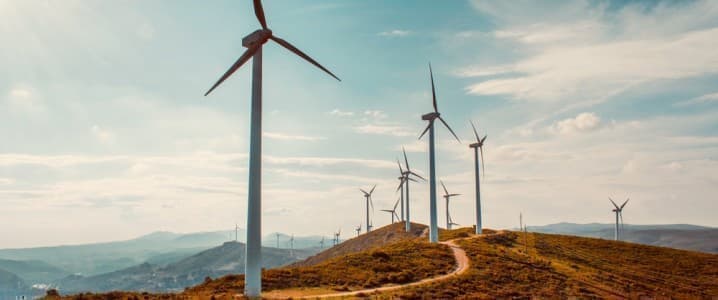Wind power had a tough year in 2021, with rising costs, supply chain issues, and low wind speeds hitting the industry hard.
Several wind energy giants, including GE, Siemens, and Orsted, saw profits fall in 2021 and their share prices tumbled as a result.
Despite these setbacks, the industry is shooting for a record-breaking year in 2022, although although a lack of certainty on critical tax policies may impact that.
Both GE and Siemens lost out on revenue from wind power last year, so what’s happening in the world of wind and can we expect better results this year? With Germany and other developed renewable energy regions experiencing low wind speeds in 2021, it has left many to wonder whether wind is the reliable form of power it’s so often been portrayed to be.
Siemens Gamesa’s renewable energy business saw its market cap almost halve over the last year as supply chain disruptions and low wind levels negatively affected operations. Siemens said its revenue dropped to $2.06 billion between October and December 2021, marking a year-on-year decrease of 20.3 percent. Operating losses totaled almost $353 million.
The company believes its revenue could contract by between 9 and 2 percent year-on-year stating, “Considering the results in Q1 FY22 and the fact that the company does not expect supply conditions to normalize in the remainder of the year, Siemens Gamesa has adjusted its guidance for FY22.”
Siemen’s share price has fallen by around 45 percent over the last year as it blamed volatile market conditions and ongoing supply chain issues – such as delays and higher raw material costs - for negatively affecting its wind energy sector. Chairman of Siemens Gamesa’s board of directors, Miguel Angel López, explained that the company was “experiencing significant challenges in its Onshore business in a very difficult market.”
This is not the only European wind energy major to feel the strain, as both Vestas and Orsted warned of difficult times for the renewable sector late last year. The Danish firms voiced their concerns over low wind speeds, ongoing challenges in the supply chain, and increasing manufacturing costs associated with wind energy operations.
Orsted saw a drop in profits in 2021 associated with lower wind speeds compared to 2020. Europe experienced some of the lowest wind speeds in decades last year. This combined with higher associated costs, from raw materials to transportation, meant a difficult year for renewable energy companies. Despite optimism coming out of the COP26 climate summit last autumn, these are inevitably the type of challenges that green energy firms can expect to face as they scale up operations in the coming years.
In terms of raw materials, steel prices soared in 2021, with the benchmark price up by 86 percent in the U.S. and 53 percent in Europe. As steel makes up a significant proportion of the structure of the wind turbines this means the cost of new wind farm projects has skyrocketed. Uncertainties surrounding costs and the reliability of wind speeds has subsequently driven down many renewable energy firms’ share prices.
In the first half of 2021, Germany reported its share of renewable energy fell to 42.6 percent of the country’s total power, down 8.1 percent. Offshore and onshore wind energy dropped by 28 percent. With Germany expected to lead the way on EU ambitions to rely entirely on renewable energy within the next decades, decarbonising its national economy, it will have to show the world how it is recovering from this volatile year going forward.
In the U.S., General Electric’s (GE) renewable energy segment also faces challenges due to rising raw materials and transportation costs negatively effecting its onshore wind operations. CEO of the firm Larry Culp stated, "I don't see the brink of a resolution just yet". And "we will see a little bit more inflation pressure in 2022," he said.
GE is battling rising costs and difficulties with the supply chain, seeking out alternative suppliers and sourcing alternatives parts to try and manage prices. The inflation felt during and following the pandemic has hit companies hard across all industries. However, burgeoning sectors like renewable energy are feeling it worse as they try and get off the ground, hitting several hurdles along the way. For GE, the doubt over whether U.S. production tax credits for onshore wind will be extended adds to the uncertainty in the sector.
But several reports still predict record wind and solar results for 2022. Despite ongoing supply chain difficulties, many experts envisage a successful year for wind and solar power thanks to low prices. Supply chain costs and delays are also expected to lessen throughout the year. However, CEO of the American Council on Renewable Energy, Greg Wetstone, stated the need for greater regulatory certainty explaining, "We’re also in a moment where we have uncertainty on critical tax policy, and unfortunately, it’s a reality that the renewables sector has had to deal with from the beginning."
Despite several challenges to the development of the world’s wind power, the Energy Information Administration (EIA) has announced plans for 21.5 GW of solar and 7.6 GW of wind in the U.S. in 2022, building upon the most successful wind, solar, and battery storage development year in history.
Renewable energy firms are hitting hurdles early in the game, following the optimism surrounding rapid expansion coming out of COP26. Siemens, Orsted, and GE have all faced losses related to low wind speeds and supply chain difficulties. However, as supply chain challenges begin to ease and more onshore and offshore wind turbines come online, we can expect to see a boost in the level of wind power in 2022 that is set to continue year-on-year.
